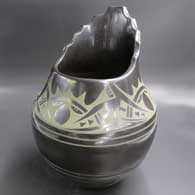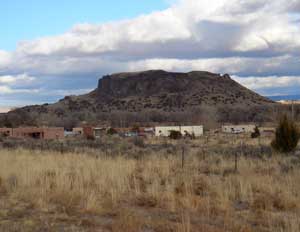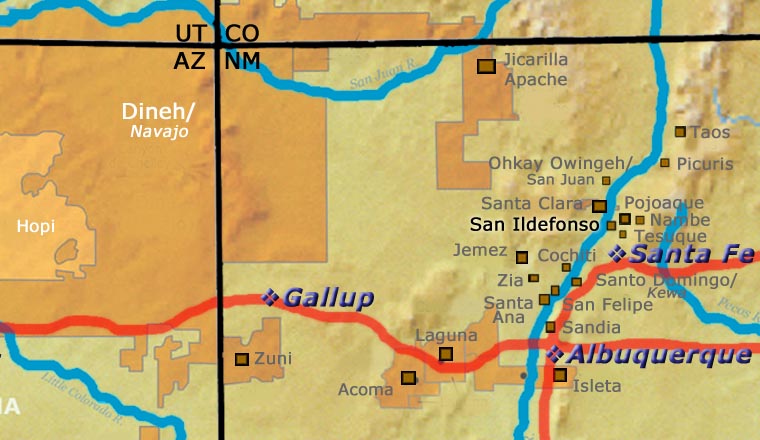
Erik Fender
San Ildefonso
Erik Fender was born in 1970. His mother is Martha Appleleaf, his grandmother Carmelita Dunlap. Johnnie Tse-Pe was his uncle.
As a boy, Erik learned about working with clay by watching his mother, his grandmother and his uncle, Carlos Sunrise Dunlap, making pottery. He couldn't keep his hands out of the clay and learned quickly. He was earning blue ribbons for his painting and for his pottery before he was 18. Sometimes his mother had him paint pots for her.
Erik developed an innovative black-on-red style where he separates bands of painted design with bands of low-relief sgraffito design. He also makes green-on-black and polychrome pots.
Erik told us he's inspired by historic pieces of San Ildefonso pottery. He feels the spirit in it and wants to keep that spirit alive in his pueblo. So in addition to creating San Ildefonso Revival styles of his own, he teaches classes in making pottery and jewelry at the Poeh Cultural Center at Pojoaque Pueblo. That's where he gets his fun: hanging out with his students and sharing insights about Tewa culture and history.
Erik says he's drawn from designs of the past to help create his own. His pots speak for themselves, and that's the kind of legacy he wants. He signs most of his pieces Than Tsideh, meaning: Sunbird.
Some Awards Erik has Earned
- 2023 Santa Fe Indian Market, Pottery Classification II C: Category 705 - Painted designs on a black or red burnished or polished surface, any form in the style of San Ildefonso: First Place
- 2020 Heard Museum Guild Indian Fair & Market, Classification II - Pottery, Division A- Painted, native clay, hand built, fired out-of-doors: First Place. Awarded for artwork: Black-on-Black Jar
- 2019 Santa Fe Indian Market, Classification II - Pottery, Division C - Traditional Burnished Black or Red Ware; Incised, Painted or Carved, Category 705 - Painted designs on a black or red burnished or polished surface, any form in the style of Ildefonso: First Place
- 2019 Santa Fe Indian Market, Classification II - Pottery, Division D - Contemporary pottery, any form or design, using Native materials with or without added decorative elements, traditional firing techniques, Category 806 - With added elements (like beads, feathers, stone, etc.): First Place
- 2019 Heard Museum Guild Indian Fair & Market, Classification II - Pottery, Division E - Any design or form with native materials, kiln fired pottery: Second Place. Awarded for artwork: "Dragonfly Vase"
- 2018 Santa Fe Indian Market, Classification II - Pottery, Division B - Traditional Painted Pottery, Category 603 - Painted Polychrome Pottery in the Style of Cochiti, Santo Domingo, Santa Clara, San Ildefonso, Tesuque, Nambe, San Juan, Pojoaque, Any Form: Honorable Mention
- 2018 Santa Fe Indian Market, Classification II - Pottery, Division C - Traditional Burnished Black or Red Ware; Incised, Painted or Carved, Category 705 - Painted designs on a black or red burnished or polished surface, any form in the style of Ildefonso: First Place
- 2018 Santa Fe Indian Market, Classification II - Pottery, Division C - Traditional Burnished Black or Red Ware; Incised, Painted or Carved, Category 705 - Painted designs on a black or red burnished or polished surface, any form in the style of Ildefonso: Honorable Mention
- 2017 Santa Fe Indian Market, Classification II - Pottery, Division B - Traditional: Best of Division
- 2017 Santa Fe Indian Market, Classification II - Pottery, Division B - Traditional, Category 603 - Painted polychrome pottery in the style of Cochiti, Santo Domingo, Santa Clara, San Ildefonso, Tesuque, Nambe, San Juan, Pojoaque, any form: First Place
- 2017 Santa Fe Indian Market, Classification II - Pottery, Division D - Contemporary Pottery, any form or design, using Native materials with or without added decorative elements, traditional firing techniques, Category 806 - With added elements (like beads, feathers, stones, etc), any form: Second Place
- 2017 Heard Museum Guild Indian Fair & Market, Classification II - Pottery, Division A - Painted, Native Clay, Hand Built, Fired Out-of-Doors: Second Place. Awarded for Art Work: Black-on-Black Jar
- 2014 Heard Museum Guild Indian Fair & Market, Classification II - Pottery, Division A - Traditional, native clay, hand built, painted: Second Place
- 2013 Heard Museum Guild Indian Fair & Market, Classification II - Pottery, Division A - Traditional, native clay, hand built, painted: Honorable Mention
- 2012 Heard Museum Guild Indian Fair & Market, Classification II - Pottery, Division A - Traditional, native clay, hand built, painted: Second Place
- 2010 Heard Museum Guild Indian Fair & Market, Classification II - Pottery, Division A - Traditional, native clay, hand built, painted: Honorable Mention
- 2009 Heard Museum Guild Indian Fair & Market, Classification II - Pottery, Division A - Traditional, native clay, hand built, painted: Second Place
- 2008 Heard Museum Guild Indian Fair & Market, Classification II - Pottery, Division A - Traditional, native clay, hand built, painted: Honorable Mention
- 2008 Heard Museum Guild Indian Fair & Market, Classification II - Pottery, Division D - Traditional native clay, hand built, figurative: Second Place
- 2005 Heard Museum Guild Indian Fair & Market, Classification II - Pottery, Division A - Traditional, native clay, hand built, painted: Honorable Mention
- 2004 Santa Fe Indian Market, Classification II - Pottery, Division D - Traditional pottery, painted designs on burnished black or red surface: Best of Division
- 2004 Santa Fe Indian Market, Classification II - Pottery, Division D - Traditional pottery, painted designs on burnished black or red surface, Category 1101 - Jars, wedding jars: First Place
- 2001 Santa Fe Indian Market, Classification II - Pottery, Division D - Traditional pottery, painted designs on burnished black or red surface (in the style of Santa Clara or San Ildefonso): Best of Division shared with Martha Fender
- 2001 Santa Fe Indian Market, Classification II - Pottery, Division D - Traditional pottery, painted designs on burnished black or red surface (in the style of Santa Clara or San Ildefonso), Category 1103 - Bowls and jars with handles: Second Place
- 2001 Santa Fe Indian Market, Classification II - Pottery, Division D - Traditional pottery, painted designs on burnished black or red surface (in the style of Santa Clara or San Ildefonso), Category 1101 - Jars: First Place shared with Martha Fender
- 1998 Santa Fe Indian Market, Classification II - Pottery, Division D - Traditional pottery, Category 1101- Jars: Honorable Mention
- 1997 Santa Fe Indian Market, Classification II - Pottery, Division C - Traditional pottery, Category 1103 - Bowls: Second Place
100 West San Francisco Street, Santa Fe, New Mexico 87501
(505) 986-1234 - www.andreafisherpottery.com - All Rights Reserved

San Ildefonso Pueblo
San Ildefonso Pueblo is located about twenty miles northwest of Santa Fe, New Mexico, mostly on the eastern bank of the Rio Grande. Although their ancestry has been traced to prehistoric pueblos in the Mesa Verde area, their most recent ancestral home is in the area of Bandelier National Monument, the prehistoric village of Tsankawi in particular. Tsankawi abuts the reservation on its northwest side.
A mission church was built in 1617 and named for San Ildefonso. Hence the name. Before that the village was called Powhoge, "where the water cuts through" (in Tewa). Today's pueblo was established as long ago as the 1300s. When the Spanish arrived in 1540, they estimated the village population at about 2,000.
That mission was destroyed during the Pueblo Revolt of 1680 and when Don Diego de Vargas returned to reclaim the San Ildefonso area in 1694, he found virtually all the Tewa people on top of nearby Black Mesa. After an extended siege the two sides negotiated a treaty and the people returned to their villages. However, the next 250 years were not good for them. The Spanish swine flu pandemic of 1918 reduced the pueblo's population to about 90. Their population has grown to more than 600 now but the only economic activity available on the pueblo involves creating art in one form or another. The only other work is off-pueblo. San Ildefonso's population is small compared to neighboring Santa Clara Pueblo, but the pueblo maintains its own religious traditions and ceremonial feast days.
San Ildefonso is most known for being the home of the most famous Pueblo Indian potter, Maria Martinez. Many other excellent potters from this pueblo have produced quality pottery, too, among them: Blue Corn, Tonita and Juan Roybal, Dora Tse Pe and Rose Gonzales. Of course the descendants of Maria Martinez are still important pillars of San Ildefonso's pottery tradition. Maria's influence reached far and wide, so far and wide that even Juan Quezada of the Mata Ortiz pottery renaissance in Chihuahua, Mexico, came to San Ildefonso to learn from her.
100 West San Francisco Street, Santa Fe, New Mexico 87501
(505) 986-1234 - www.andreafisherpottery.com - All Rights Reserved

